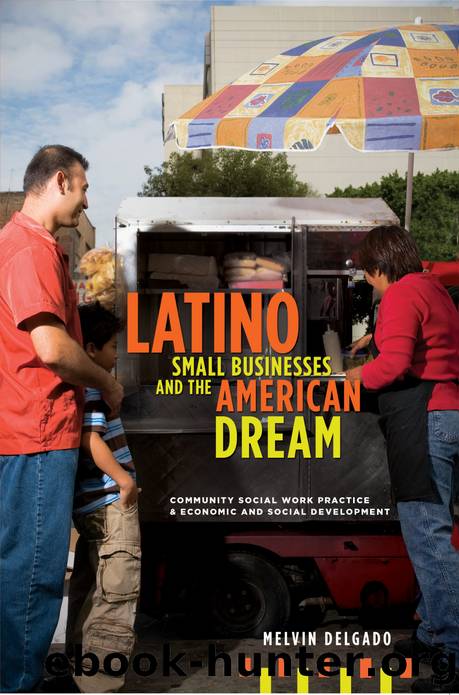Latino Small Businesses and the American Dream by Melvin Delgado

Author:Melvin Delgado
Language: eng
Format: epub
Tags: Social Science/Social Work
Publisher: Columbia University Press
Published: 2011-09-06T00:00:00+00:00
PURCHASING POWER
By 2010 people of color will control one quarter of U.S. purchasing power (Cohn 2007). In 2007 African Americans accounted for $845 billion and Latinos for $860 billion in economic power (Miller 2008). One report, although written in 2000 and based on 1998 dollars, projects communities of color as having purchasing power of $6.1 trillion by 2045 (U.S. Department of Commerce 2000). A Philadelphia economic conference organizer notes that these two groups share much in common: âWe have similar food, music, dance and history, and we share the struggles we have to faceâ (Miller 2008:1), Philadelphia's Latino community has grown substantially over the past two decades and in 2001 numbered 129,000, or 8.5 percent of the city's population (Bartelt 2001). The nation's inner cities represent $85 billion in retail purchasing power, or 7 percent of the entire nation's purchasing power, more than the formal retail market of Mexico (McQueen, Weiser, and Burns 2007).
Latino buying power increased by 247 percent from 1990 to 2006 (Turner and Czekalinski 2007) and increased steadily from 2002 and 2008. In 1990 Latino buying power was calculated at $212 billion. In 2003 it was $600 billion, up from $540 billion in 2002. In 2006 it was estimated to be slightly under $800 billion, increasing to $863 billion in 2007 (Selig Center for Economic Growth 2006). In 2008 it stood at $980 billion (Hispanic Market Weekly 2009). A billion dollars in purchasing power translates into $1.9 million per minute (Montemayor and Mendoza 2004). Finally, the purchasing power of this community is projected to reach $1.2 trillion dollars in 2011 (Selig Center for Economic Growth 2006) and $1.3 trillion in 2013 (Hispanic Market Weekly 2009). This translates into more than 450 percent growth between 1990 and 2011, with non-Latino purchasing power increasing close to 176 percent during the same period. Another estimate has Latino purchasing power increasing by 31 percent from 2009 to 2014 (Best 2009).
These increases constitute several times the overall national rate of consumer purchasing power over the past decade (U.S. Hispanic Chamber of Commerce 2007). Further, as noted earlier in this chapter, the number of Latino households with incomes of at least $100,000 increased by 137 percent between 1990 and 2000, indicating the rise of an economic class with even greater purchasing potential in the early part of the twenty-first century. The Latino middle-class bracket ($35,000 to $99,999), too, witnessed an increase of 40 percent (Cohn 2007).
It is estimated that Latino consumers in the United States will contribute fifty-six years of spending during their lifetime as compared with non-Latinos, owing to their median age of 27 and life expectancy of 83. In 2008, 67 percent of Latinos were under the age of 34 and represented 24 percent of all babies born in this country (Belanger 2009).
Morrison (2006) touches on the youth sector of the Latino market: âAfter decades of being ignored, urban Latino youths are now regarded in the corporate realm as the âhottestâ and fastest-growing segment of America's consumers. Pegged by market boosters
Download
This site does not store any files on its server. We only index and link to content provided by other sites. Please contact the content providers to delete copyright contents if any and email us, we'll remove relevant links or contents immediately.
| Business School Guides | GMAT |
| Guides | Interviewing |
| Job Hunting | Job Markets & Advice |
| Resumes | Vocational Guidance |
| Volunteer Work |
The Motivation Myth by Jeff Haden(5158)
Audition by Ryu Murakami(4851)
Adulting by Kelly Williams Brown(4489)
The Confidence Code by Katty Kay(4190)
A Mind For Numbers: How to Excel at Math and Science (Even If You Flunked Algebra) by Barbara Oakley(3223)
Waiting in the Wings by Melissa Brayden(3181)
Self-Esteem by Matthew McKay & Patrick Fanning(3093)
Fooled by Randomness: The Hidden Role of Chance in Life and in the Markets by Nassim Nicholas Taleb(3049)
The ONE Thing by Gary Keller(3010)
Nice Girls Don't Get the Corner Office by Lois P. Frankel(2997)
The Dictionary of Body Language by Joe Navarro(2947)
How to be More Interesting by Edward De Bono(2749)
Designing Your Life by Bill Burnett(2667)
Getting Things Done by David Allen(2646)
The Plant Paradox by Dr. Steven R. Gundry M.D(2548)
Police Exams Prep 2018-2019 by Kaplan Test Prep(2488)
What Color Is Your Parachute? 2015 by Richard N. Bolles(2264)
Dangerous Personalities by Joe Navarro(2234)
When to Jump by Mike Lewis(2205)
